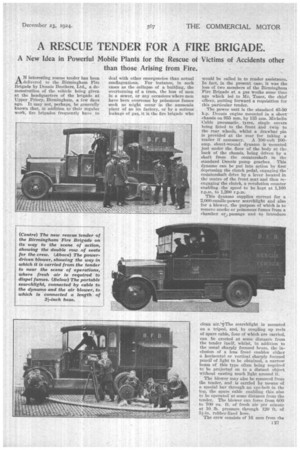A RESCUE TENDER FOR A FIRE BRIGADE.
Page 11

Page 12

If you've noticed an error in this article please click here to report it so we can fix it.
A New Idea in Powerful Mobile Plants for the Rescue of Victims of Accidents other than those Arising from Fire.
AN interesting rescue tender has been delivered to the Birmingham Fire Brigade by Dennis Brothers, Ltd., a demonstration of the vehicle being given at the headquarters of the brigade at Upper Priory, Birmingham, a few days ago. It may not, perhaps, be generally known that, in addition to their regular work, fire brigades frequently have to
deal with other emergencies than actual conflagrations. For instance, in such eases as the collapse of a building, the overturning of a tram, the loss of men in a sewer, or any occasions where men have been overcome by poisonous fumes such as might occur in the ammonia plant of an ice factory, or by a serious leakage of gas, it is the fire brigade who would be called in to render assistance. In fact, in the present case, it was the loss of two members of the Birmingham Fire Brigade at a gas works some time ago which led to Mr. Tozer, the chief officer, putting forward a requisition for this particular tender.
The power unit is the standard 45-50 b.p. Dennis engine mounted in a short chassis on 955 mm. by 155 mm. Michelin Cable pneumatic. tyres, single covers being fitted to the front and twin to the rear wheels, whilst a drawbar pin is provided at the rear for taking a
trailer if necessary. A 100-volt 100amp. shunt-wound dynamo is mounted just under the floor of the body at the back of the chassis, being driven by a shaft from the countershaft in the standard Dennis pump gearbox. This dynamo can be put into action by first. depressing the clutch pedal, engaging the countershaft drive by a lever located in the centre of the front seat and then reengaging the clutch, a revolution counter enabling the speed to be kept at 1,100 r.p.m. to 1,200 r.p.m.
This dynamo supplies current for a 2,000-candle-power searchlight and also for a blower, the purpose of which is to remove smoke or poisonous fumes from a chamber or passage and to introduce clean air.'IlThe searchlight is mounted on a tripod, and, by coupling up reels of spare cable, four of which are carried, can be erected at some distance from the tender itself, whilst, in addition to the usual sharply focused beam, the inclusion of a lens front enables either a horizontal or vertical sharply focused pencirof light to be obtained, a narrow beam of this type often being required to be projected on to a distant object without casting much light around it.
The blower may also be removed from the tender, and is carried by means of a special bar through an eye-bolt in the top, the spare cable enabling this also to be operated at some distance from the tender. The blower can force from 600 to 700 cu. ft. of fresh air per minute at 10 lb. pressure. through 120 ft. of rubber-lined hose.
The crew consists of 16 men from the • i27 Rescue Corps, all of whom have been trained and have obtained their certificates of proficiency at the University of Birmingham. These men, who are accommodated beside the driver and in a compartment behind him, which also contains the switchboard, are provided with eight sets of Proto breathing apparatus, each sufficient to provide artificial respiration for 13 hours, while there are also eight spare oxygen cylinders contained in lockers on each side of the tender, which add a further 13 hours use to each apparatus. Thus equipped and provided for, the men can carry nut extensive work in a poisonous or smokefilled atmosphere.
Two connections are provided on the switchboard for running hand cluster lamps for the interior lighting of a building, whilst there are compartments for carrying eight electric hand lamps and other spare equipment, such as life lines and belts.
In addition to the main dynamo, an independent C.A.V. vehicle lighting set, the dynamo of which is driven from the engine, is provided for the headlamps and for lighting the switchboard and compartments in which the various gear is stowed. Other equipment includes an oxygen reviving apparatus, the four cable reels mentioned above, each containing 50 yds. of twin cable, being carried in lockers behind the running boards, which themselves form tool boxes.
The tender is provided with dual ignition and C.A.V. car lighting set, the regulation fire-engine bell and a Klaxon horn being provided as warning dlevices. The tender is capable of a speed of 30 m.p.h., and, upon arrival at the scene of operations, can be in full working order within three minutes. At the demonstration the blower and searchlight were shown in working order, whilst the men paraded with full breathing apparatus and hand lamps, and the speed with which the gear could be put in action and stowed away again was also shown.
The example set by Birmingham Fire Brigade in equipping itself with this extremely useful appliance is sure to be followed in other cities.
































